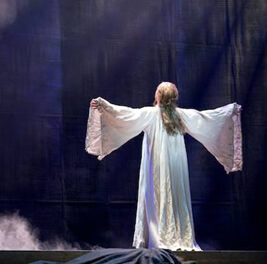Isabel Leonard, a relatively young mezzo-soprano from New York, and the University of North Carolina’s Symphony Orchestra, under the highly skilled direction of conductor Tonu Kalam, treated the audience in UNC’s Memorial Hall to an exceptionally well-performed concert of literature from the last half of the 19th century into the early 20th. The concert was presented under the auspices of Carolina Performing Arts.
The 90-piece orchestra, drawn from UNC’s music majors and non-majors, opened the concert. The first work on the program, Modest Mussorgsky’s Night on Bald Mountain (1867), was executed with precision and decisiveness. Its variety of tone colors contrasted throaty sounds from the brass against quiet muted strings along with beautiful flute and clarinet solos alternating with full orchestral outbursts, some set in half steps intensely depicting spirits of darkness. Kalam well understood the emotional map of this work and had trained these young musicians to be so attuned to his gestures that the audience received the depth of his interpretations.
In addition, the orchestra opened the second portion of the concert with George Butterworth’s A Shropshire Lad (1912). The simplicity of its lines stood out in stark contrast to the opening work by Mussorgsky. The viola section drew attention to itself for the lushness and warmth of its tones.
Leonard sang one three-movement work, Shéhérazade (1903), by Maurice Ravel, which was programmed as the other work on the first half of the concert. The first movement, “Asia,” portrays elegant scenes from Damascus to China, accompanied by impressionistic music painting as a backdrop for the text. With the dramatic richness of Leonard’s beautiful sound, her voice responded with ease to varying colors of the text. The second movement, “The Enchanted Flute,” gave co-principal flutist Julia Yeh a prominent and well-done role energizing this movement with depictions of the feelings in the text that she performed from her heart. The short third movement, “The Indifferent One,” which is a description of attractive features of a girl, begins in a slow, reflective tempo as if contemplating loss of the features of youth, expressed by Leonard spinning her slow-moving tones with beauty.
Leonard completed the program with a set of arias by three different composers. The first set included two arias from Gounod’s Faust (1859), “He was a King of Thulé” and the “Jewel Song.” Both were dramatically sung, full of vocal virtuosity, through which Leonard displayed a coquettish flair, wowing the audience. Kalam followed to perfection the expressive tempo changes made by Leonard within phrases. Further, the orchestra players were so very attentive to the unusual clarity in his conducting with its frequent minimalist motions.
The aria, “Love’s Fiery Flame” from The Damnation of Faust (1845-46) by Hector Berlioz appeared next on the program. Leonard sang the off-beat notes in quick succession with great skill in this intense aria. Unfortunately, the English horn player evidently had pitch problems with the horn. Double-reed instruments can easily be temperamental.
The final aria on the program, came from Bizet’s Carmen (1873-74), “Love is Like a Wild Bird,” also known as “Habañera.” Leonard and the orchestra brought out all their skills navigating expected and possibly unexpected pauses and holds in this well-known aria.
After several curtain calls, Leonard returned to the stage for her last curtain call and invited the audience to join her in singing “Somewhere” from Leonard Bernstein’s West Side Story.
Leonard’s voice combined the agility of a coloratura soprano with the depth of a mezzo-soprano. She exuded warmth, creative sparkle, and vivaciousness in her personality and vocal delivery. We look forward to following her career, for it sounds like many new doors will be available for her to walk through in the future, as they have already.
So much of this program must have been a challenge for the 90-student symphony orchestra morphed into an opera orchestra. What they achieved in terms of unity in navigating opera scores is quite remarkable. They showed their complete concentration on the difficult tasks at hand – so much so, they began to match the standards of well-trained opera orchestras. Kalam clearly stands as a master teacher, unifying these 90 minds – without a glitch. This is not only a result of Kalam’s inner musical sensitivities but also from the clarity and economic efficiency of his conducting style. He is, without a doubt, one of the jewels in the crown of UNC’s music department faculty.











